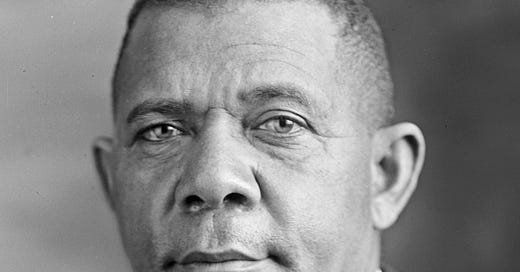The Legacy of Booker T. Washington
He founded Tuskegee Institute and the National Negro Business League
Issue #104 Education August 10, 2022 (approximately 4 minutes reading time)
The end of the 19th century and the beginning of the 20th century, the post-reconstruction era, saw several initiatives put in place to help the transition of formerly enslaved African-Americans. Two of the leaders of Black thought were Dr. W.E.B. DuBois and Booker T. Washington. Dr. DuBois advocated for higher education and political change while Mr. Washington believed that vocational education and biracial cooperation were the better paths.
I wrote about Dr. DuBois in a previous “We Are Speaking” article:
The Life of Booker T. Washington
Booker Taliaferro was born on April 5, 1856, in Franklin County, Virginia. His mother was an enslaved cook while his father was an unknown white man. When he enrolled in school, Booker gave himself the surname of Washington. He was a slave during the first nine years of his life, but after the Civil War and Emancipation, his mother, who had married and had three other children, moved the family to Malden, West Virginia to join her husband who was working in the salt mines. As a child, while attending school, Booker worked in the mines and on other manual jobs.
At age 16, Washington enrolled at Hampton Normal and Agricultural Institute in Virginia, which was opened in 1868 by the American Missionary Association. The educational philosophy at Hampton was that students should learn practical and utilitarian skills while strengthening their character and morality.
Washington graduated from Hampton with honors in 1875 with a strong belief in an educational system that emphasized practical skills and self-help.
After several years of teaching at Hampton and getting additional education, Washington was invited to be the principal of a new school in Alabama for training Black teachers, the Tuskegee Normal School.
Although the state of Alabama appropriated funds for salaries, there was no land or buildings for the new school. Tuskegee first opened on July 4, 1881, in a shanty loaned to him by the local A.M.E. church. Meanwhile, Washington secured a loan from the treasurer of Hampton Institute and bought a 100-acre former plantation. The Tuskegee students built a kiln and sold bricks to raise money, and over the next few years, they built a classroom building, a dining hall, a girls’ dormitory, and a chapel.
By 1888, Tuskegee Institute had grown to 540 acres and over 400 students, with a rigorous schedule and a curriculum that emphasized vocational and domestic courses, personal hygiene, and character building. Dr. George Washington Carver was one of the illustrious teachers at the school when he was appointed director of the agricultural program.
By the 25th anniversary of Tuskegee Institute in 1906, Tuskegee Institute included a 2000-acre campus and 83 buildings. There was an endowment fund worth $1,275,644, or about $35,434,555 in today’s dollars.
The Legacy of Booker T. Washington
Washington was a prolific author, publishing 40 books by 1912.
He was also a highly sought-after public speaker. His first national speech, titled “The New Negro,” was given on the opening day of the 1895 Atlanta Exposition.
On October 1, 1901, Washington was the first Black person to dine at the White House when he was a guest of President Theodore Roosevelt. Washington went on to counsel presidents until his death in 1915.
Dr. DuBois, who initially supported Mr. Washington, coined the term “The Atlanta Compromise” after Washington’s speech at the Atlanta Exposition in 1895. DuBois preferred a more activist approach to fighting racism and improving educational opportunities for Blacks, while Washington promoted a slower approach to avoid white backlash. The viewpoints of the two leaders reflected their different geographical locations and backgrounds: DuBois was born free in the North while Washington was born a slave in the South.
Booker T. Washington was the first Black person to have their image on a U.S. Postage stamp. President Franklin Delano Roosevelt authorized the stamp as part of the Famous Americans series. Another stamp honoring Washington was released in 1956 for the 100th anniversary of his birth.
Washington, ever the educator, partnered with the CEO of Sears, Julius Rosenwald, a Tuskegee Institute board member, to create over 5,000 schools in rural communities throughout the South. The Rosenwald Rural Schools, often staffed with teachers who were graduates of Tuskegee Institute, helped educate over 660,000 Black children in the South, or more than 1/4 of Black children at that time.
Although he was thought to be too “accommodating” to the white supremacists and Jim Crow laws of his time, Washington actually privately substantially contributed to various legal challenges to segregation and disenfranchisement.
Booker T. Washington continued as the principal of Tuskegee Institute throughout his life. In 1915, he collapsed in New York City and was told he had only a few days left to live. He boarded a train to Tuskegee and arrived there shortly after midnight on November 14, 1915, where he died a few hours later at age 59. It was later decided that he died of hypertension, high blood pressure, and kidney failure.
For decades in the 20th century, Washington was criticized by the NAACP (co-founded by DuBois) and the civil rights community for being too accommodating to white supremacy. By the end of the 20th century, however, most Black people and organizations, particularly Black business organizations, have tempered their views of Washington and defined and celebrated his accomplishments, legacy, and leadership in working with others to uplift the Black community, particularly in the South during very perilous times.
What do you know about Booker T. Washington? Did you learn anything new from this article? Let us know in the comments.
Help us to get to 100 subscribers!
You’ll love the iOS app!
We appreciate your free or paid support!






